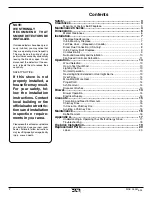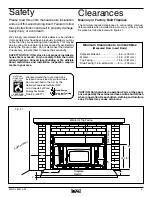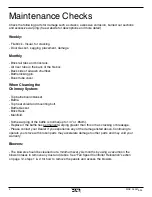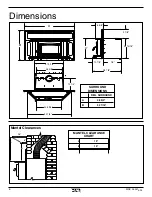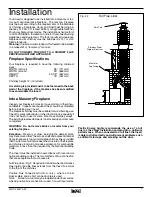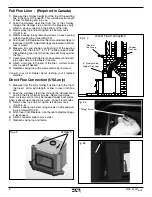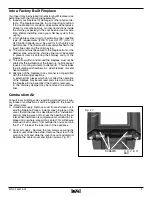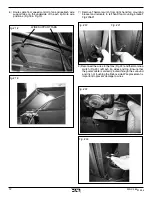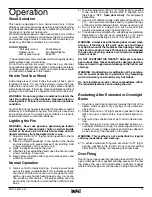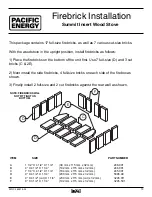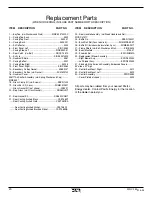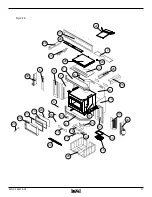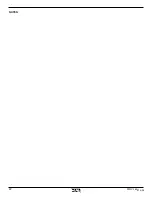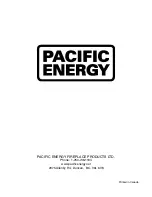
14
SINC 250314-24
More Wood, More Heat
Seasoned wood has approximately 7500 BTU’s per pound.
If you put 10 pounds of wood in your stove for an eight hour
burn the wood will be producing 9375 BTU’s per hour. (7500
BTU x 10 lbs / 8 hrs. = 9375 BTU’s per hr.). If you put 20 lbs of
wood in your stove for an eight hour burn you will get 18,750
BTU’s per hr. (7500 BTU x 20 lbs / 8 hrs. = 18,750 BTU’s per
hr.). This is only an example and is based on 100% efficiency.
In reality, your stove should perform above the 80% range.
Experience will give you the right settings for proper combus-
tion and efficient burning. Remember, the air inlet setting is
affected by variables such as type of wood, outside tempera-
ture, chimney size and weather conditions. With practice, you
will become profi cient in operating your heater and will obtain
the performance for which it was designed.
Proper Draft
1) Draft is the force which moves air from the appliance up
through the chimney. The amount of draft in your chimney
depends on the length of the chimney, local geography,
nearby obstructions and other factors.
2) Too much draft may cause excessive temperatures in the
appliance. An uncontrollable burn or a glowing red stove
part or chimney indicates excessive draft.
3) Inadequate draft may cause backpuffing into the room and
plugging of the chimney. Smoke leaking into the room
through appliance and chimney connector joints indicates
inadequate draft.
Ash Removal
Whenever ashes get 3 to 4 inches deep in your fi rebox, and
when fi re has burned down and cooled, remove excess ashes.
Leave an ash bed approximately 1 inch deep on the fi rebox
bottom to help maintain a hot charcoal bed.
Disposal of Ashes
Ashes should be placed in a metal container with a tight fi t-
ting lid. The closed container of ashes should be placed on
a non-combustible fl oor or on the ground, well away from all
combustible materials, pending fi nal disposal. If the ashes
are disposed of by burial in soil or otherwise locally dispersed,
they should be retained in the closed container until all cinders
have thoroughly cooled. Other waste should not be placed
in this container!
Blower
The Insert comes equipped with twin variable speed cir-
culating air blowers. The blower system is thermostatically
controlled for automatic operation, as well as manually with
a convenient bypass switch.
Blower Operation
Automatic: To operate the blowers automatically, push the
rocker switch to the “OFF” position and set the fan speed
control to a desired setting.
This will allow the blowers to turn on automatically once the
Insert has come up to operating temperature. It will also shut
the blowerS off after the fi re has gone out and the appliance
has cooled to below a useful heat output range.
Manual: To manually operate the blowers, push the rocker
switch to the “ON” position and set the fan speed control to a
desired setting. This will bypass the temperature switch and
allow full control of the blowers.
Suggested settings:
- Combustion air control setting of “L” (low) position (pushed
to the far right), operate blower speed control on “Low”.
- Combustion air control set at anything above “L” (low),
operate blower speed control at desired setting.
Electrical Supply
Circulating air blower electrical rating; 115V, 60 Hz, 0.7 A.
For your protection against shock hazard, use only a properly
grounded outlet that will accept a three-pronged plug. Do
not cut or remove the grounding prong. Do not route power
cord under unit. Power cord must be routed to avoid contact
with any hot or sharp surfaces.
Consult local codes or, in the absence of local codes, with
the current CSA C22.1 Canadian Electrical Code and in the
USA with the National Electrical Code, ANSI/NFPA 70 (lat-
est edition).
L2 (black)
G (green)
L1 (white)
Speed
Control
Blowers
Thermo
Switch
By-pass
Rocker Switch
Electrical Rating : 115 V, 60 Hz, 0.7A
Fig. # 24
Содержание SUMMIT INSERT
Страница 21: ...SINC 250314 24 21 Fig 25...
Страница 22: ...22 SINC 250314 24 NOTES...


